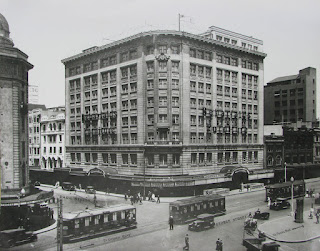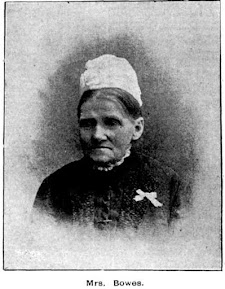A Landmark retail corner in Sydney
In the age of the changing face of
"retail" it's nice to know that some things remain the same albeit
slightly different in execution.
Many retail stores over the past 150+ years have
been taken over by others or even disappeared. Names such as Hordern's,
Farmers, Marcus Clark, Nock & Kirby, Ways, Gowings, Grace Bros.,
Buckinghams, Mark Foys, Beard Watson etc spring to mind.
The retail empire that I'm showcasing today, had
a name now lost to history but the area where it once stood is still a retail
hub and shortly to undergo a bit of a "spruce up".
Photo from City of Sydney collection
Let me introduce Bebarfalds and it's founder....
BARNET BEBARFALD
Barnet was born in Prussia in 1831, one of seven
children to Myer and Sophia. The family left the country and moved to England
residing in Middlesex during the time of the 1851 census. Myer was listed as a
cap maker and Barnet, now twenty years of age, a cigar maker.
It appears that Barnet departed London in August
1852 and arrived in Melbourne later that year and by 1857 was in partnership
trading as Harris & Bebarfald, as importers. He returned to England in 1858
and married Frances "Fanny" Davis the following year and returned to
Melbourne. By 1860 Bebarfald set up his own business as an importer and next
moved to Dunedin New Zealand to conduct an importing business however this
failed and he and his family returned to Sydney in the early 1870's.
By 1873 Bebarfald is listed in the Sands Sydney
directory as operating a "furniture warehouse" at 256 Pitt Street, which
at that time was in the vicinity of the current George and Pitts Street
intersection.
Furniture retailers were plentiful in central
Sydney up until the mid-twentieth century when they moved to suburban
locations, and Bebarfald's was to become one of the largest.
Image from Sydney Living Museums collection
Unfortunately Barnet Bebarfald died on 28th April
1894 aged 69 leaving a wife and four children to mourn his loss. He is buried
in the old Jewish section of Rookwood.
Barnet left the business in sound measure, notwithstanding
a severe recession that occurred in the 1890's and by 1899 the company acquired
the adjoining premises and in 1907 constructed a new four-storey building
across the site. In addition to furniture the store stocked, bedding, linoleum,
carpets, drapery, manchester, crockery, glassware, ironmongery, pianos,
mangles, perambulators and even go carts!
Bebarfald’s became best remembered for their
Bebarfald-BlueBird sewing machines, introduced in 1927. Elegant timber cabinets
made at their furniture factory hid sewing machines, creating the look of a
substantial piece of furniture that would sit in harmony with other home furnishings.
Bebarfald’s offered customers free dress making courses and established an
advisory bureau.
Park Street was progressively widened from the late 1920s until the mid-1930s and Bebarfalds’ new corner building had to be set back to allow the street to be realigned and widened. The architectural firm of Kent and Massie designed Bebarfalds’ eight-storey commercial shopfront and warehouse, with a basement level, in 1926, overseen by Bebarfald’s grandson, De Rienzi Myer Rich. Once the new store was completed in 1929, the whole of the second floor was converted into display rooms; nine fully furnished period rooms as well as a complete six-room Spanish Bungalow style home with textured salmon coloured exterior, Spanish tiles and courtyard featuring flower beds, trellises and pergolas!
In 1931 the company invited Woolworths to open a branch across a section of the ground floor space.
Expansion of the business included the opening of
new regional branches with a BlueBird sewing machine showroom in Brisbane. After
WW2 suburban branches were opened but in 1968 the company was taken over by
Ajax Insurance Limited. Bebarfald’s suburban stores continued to trade under
their own name until 1973 when they became part of Macy’s Emporium (Sydney) Pty
Ltd.
In relation to the landmark original store,
Woolworths obtained the long term lease of Bebarfald's city store in 1965 but only used the basement and first two floors for retailing, the other floors being taken by offices. In 1967, two additional floors were added.
In an interesting aside, Barnet Bebarfald's daughter, Sophia, married Harry Boan who established Perth's largest store, Boan Bros, later Boan's Limited, with his brother Benjamin.
Not long ago I saw a newspaper article about the repainting and repairs of the building by the Council of Sydney who have owned the landmark since 1985. The lower ground and ground floor have been used as a supermarket for many years but will be undergoing some changes as retail pivots to accommodate our busy lifestyles.
Rookwood is home to many other family retail dynasties with the resting places of Anthony and Samuel Hordern, Preston and John Gowing and David Jones coming to mind.
Do any of you remember Bebarfald’s city or suburban stores? Does anyone still possess a BlueBird sewing machine or cabinet?
Share your memories via comments on this blog or on the associated Facebook group page, just type in rookwoodcemeterydiscoveries and scroll until you find the page. I’m sure many of us would like to hear personal tales of this company.
For more information on Bebarfald’s head to the Sydney Living Museums or Dictionary of Sydney website for starters. Their information has been of great help and assistance n writing this blog.







Did Sydney have a synagogue in the late 19th century? Was there much of a community back then? I guess there must have been if there a Jewish section in Rookwood.
ReplyDeleteYes there were Synagogues and a large Jewish population commencing from the First Fleet. The magnificent Great Synogague in Pitt Street was built in 1878 and designed by Thomas Rowe who was not Jewish. HIs first wife is buried in Rookwood with a beautiful monument
ReplyDelete